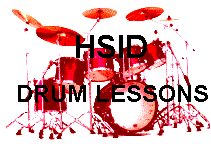|
Downloads *
Drummers Trivia *
Drummers Chat Rooms *
Rudiments *
Digital Music *
Knowledge Assessments *
TD Archives *
Drum Set Buyers Guide *
Bass-Player Jokes *
Assembling a Drum Set *
Parts of a Drum Set *
About HSID *
Video Troubleshooter
Bill Powelson's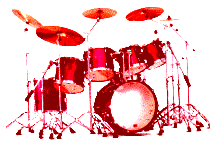 School of Drums
School of Drums
PRIVATE DRUM LESSON 9 E-M
"DISCO": 'Overhand 16th 4/4'
Copyright 1998 Bill Powelson all rights reserved

DISCO
This beat might best be called '0verhand
16th 4/4'. It got stuck with the undeserved 'Disco' handle back in the 70s and in many
minds, the name doesn't do this interesting pattern justice. The truth is, this fascinating pattern existed before the so-called
Disco era and it has survived it. This form of 16th 4/4 is still very popular
today and it should be for many years to come.
As a quick 'nutshell' description, this pattern is really just a 16th 4/4 rock beat but the
16th notes on the hi-hat are played with both hands as a single stroke roll.
I will lay it out very simply here in graduated steps but make no mistake . . . it
is easy to quickly get complex with this one. The more we experiment with this beat
the more variations we discover. It is akin to 8th rock in the sense that
all of our bass variations and syncs will be almost the same. In other
words the more comfortable we are with 8th rock bass variations and syncs,
the more fun we will have with 16th Disco.
SIMPLE DISCO
This first beat (below) is about the simplest form of Disco. You will be
playing a single roll on top of a closed hi-hat and placing a bass note
along with the first of every eight notes. Repeat this pattern until you can play it at lightning speeds. Not only are you mastering the Disco beat but this is a great exercise for helping students develop lightning speed with 16th singles.
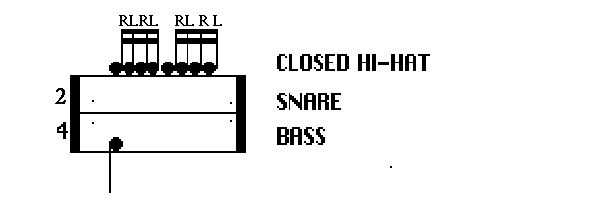
 Hear the way SIMPLE DISCO will sound. Listen closely to the cymbal rhythm. It is very difficult to hear it. Hear the way SIMPLE DISCO will sound. Listen closely to the cymbal rhythm. It is very difficult to hear it.
BASIC DISCO
The next trick is to maintain the same steady roll as above but simply come off the hi-hat, play a snare on the backbeat (in place of the 5th cymbal note) then return to the hi-hat again by the next right hand note. It is really the exact same thing as the Simple Disco beat above but we will make a quick detour to the snare on every 5th (hi-hat)cymbal note.
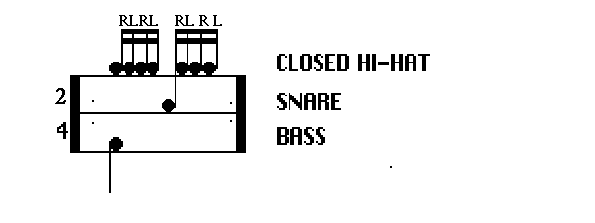
 Now listen to BASIC DISCO. Pick out the snare note. This is a right-hand note (for all but the left-handed students.) Simply move off the hi-hat for just that one note in each repetition.
Hit the snare once then move back to the hi-hat. If you are playing on simulated drums . . . use your imagination and two objects (use one object as a hi-hat and another
as a snare drum.) Now listen to BASIC DISCO. Pick out the snare note. This is a right-hand note (for all but the left-handed students.) Simply move off the hi-hat for just that one note in each repetition.
Hit the snare once then move back to the hi-hat. If you are playing on simulated drums . . . use your imagination and two objects (use one object as a hi-hat and another
as a snare drum.)
STANDARD DISCO:
This is essentially the same beat, but now we are placing an additional
bass drum along with the backbeat. This form of Disco is very common
but also very limited. The bass is so busy that there isn't much room for anything
else. While you may need this form of the beat occasionally, the basic
form (above) is much more flexible. When playing the basic form, you
will discover that injecting bass variations and syncopations will come natural.
As I said earlier, all of your routine 8th rock variation ideas (like fatback
and others) will come easy and natural when focusing on the basic form of the
beat pattern.
At any rate it will be wise to develop confidence with both forms.
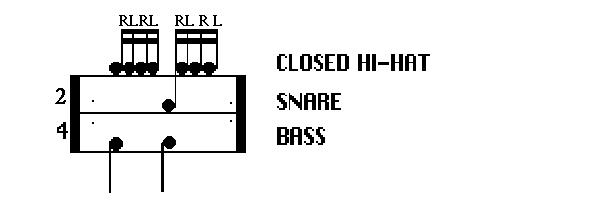
 STANDARD DISCO (ABOVE): Listen for that extra
bass drum. STANDARD DISCO (ABOVE): Listen for that extra
bass drum.
I have written these patterns in 2/4 time for simplicity. 16th Disco is
normally written in 4/4. As you see below, when written in 4/4 time
the pattern looks more complex but it is really just two repetitions
of the same thing.

As you gain confidence and speed with the basic disco pattern, try
playing the fatback bass patterns we studied in the rock variations
lesson.
 Disco Fatback might
sound something like this, but you can do almost anything you wish with
the bass. There are something like 65,536 possible variations with
just the bass drum in this framework. Disco Fatback might
sound something like this, but you can do almost anything you wish with
the bass. There are something like 65,536 possible variations with
just the bass drum in this framework.
There's more! Try playing occasional open hi-hat notes too. Just lift the hi-hat
pedal and strike the top cymbal while it is in the up position . . . then close it
on the next count.
 STANDARD DISCO WITH OPEN 'AND' HI-HAT NOTES (above.) STANDARD DISCO WITH OPEN 'AND' HI-HAT NOTES (above.)
EVEN MORE . . .
In addition to all of the above, try switching from 16th Disco to 8th rock
and back without losing tempo. The beat tempo will remain the same but as you
return to 8th rock, the number of cymbal notes will be cut in half. Also the
left hand will return to its normal position on the snare.
 VIDEO: Click here to 'Play', see, and hear everything in this entire lesson, at a moderate tempo. VIDEO: Click here to 'Play', see, and hear everything in this entire lesson, at a moderate tempo.

Copyright Bill Powelson 1996 all rights reserved.
| 

